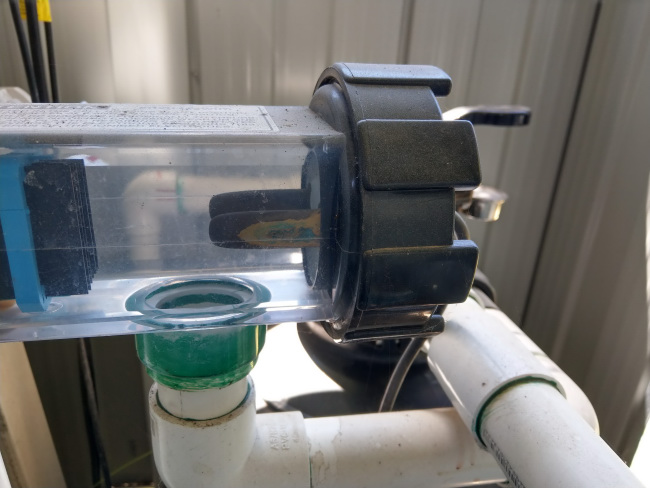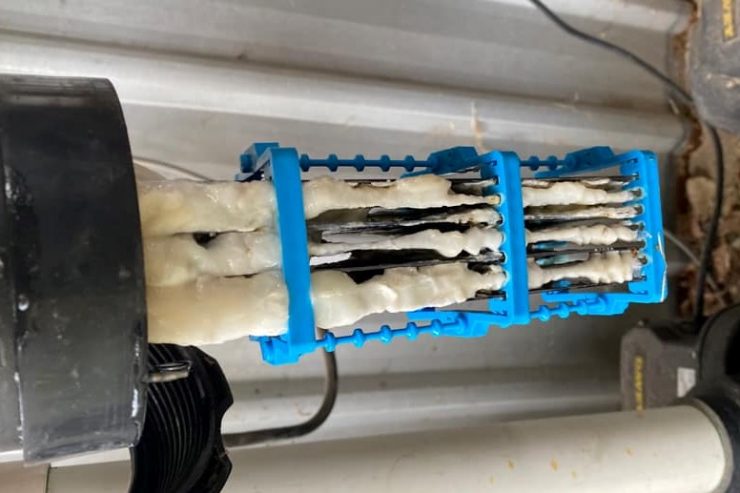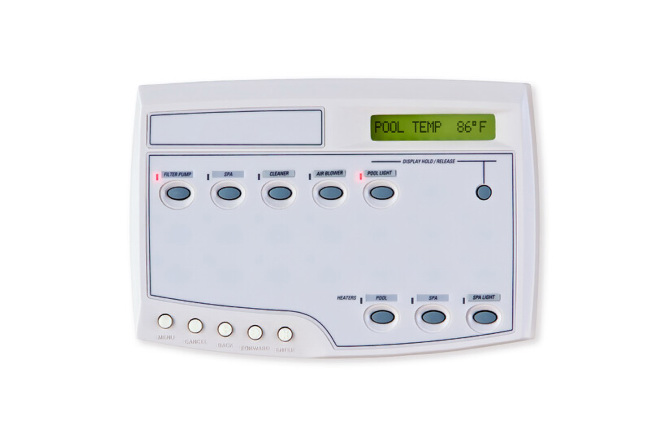Saltwater swimming pools rely on saltwater chlorine generators or SWGs to produce chlorine to keep your pool clean. Each salt cell (aka saltwater cell) in the generator converts sodium chloride into chlorine through a process called electrolysis. Yet no salt cell lasts forever. When should you replace yours?
The average lifespan of a salt cell in an SWG is 5-7 years when running the chlorine generator 8-12 hours per day. Pentair gives 10,000 hours as the lifespan on one of their cells. Some pool owners have reported getting 7,8 and even 9 years out of their cells. By testing your salt cells, you can determine if yours need repairs or even a replacement.
This article will be your guide to saltwater cell replacement.
First, we’ll talk further about the lifespan of saltwater cells as well as how to determine if they’re working. If you need to get a new cell, we’ll discuss replacement costs as well.
Let’s get started!

Article Contents
How Long Do Salt Cells Last?
As the salt cells in your SWG continue to make chlorine so your saltwater pool is swimmable, little by little, they lose their efficiency. We’ll talk in the next section about how to be sure whether your salt cells are operational, but for now, how long can you expect the cells to last?
A saltwater cell lasts for about five years, which is roughly 10,000 hours when running it an average of 6 hours per day. That’s not a bad lifespan at all, as these cells are quite durable!
You might say that I run mine more than 6 hours a day. And that may be true in the summer, but chances are in winter you may only run it for a few hours per day.
Of course, going through the time and expense of replacing the salt cells is nothing any pool owner wants to do. Can you milk your salt cells to maybe get a few more months out of them?
Yes, you can, and in two ways. Let’s talk about those methods now.
Related Reading: When & How Often To Clean Pool Salt Cell? (Answered!)
How to Look After Your Salt Cell
Keep the Pump Running
The biggest enemy of salt cells is calcium carbonate buildups, also known as scale. If you read our post about white flakes in your saltwater pool, those are pieces of calcium carbonate that have sloughed off the generator and made it into your pool.
In some regard, calcium carbonate buildup is inevitable due to the inclusion of sodium chloride in the SWG process. Sodium chloride can accelerate the amount of scale in on the salt cell.
When the pump turns off at the same time as the salt cell, this allows the sodium chloride to sit and build up scale even more. Whenever you can then, you want your pump to run a little longer.
The SWG will naturally turn itself off for periods, and this is fine. If you can time it, try to keep your pool pump on during these periods of generator inactivity, that will extend the life of your salt cell.
Clean the Cells
Another option that may prolong the life of your saltwater cells is cleaning them. This is something else we talked about in that post about calcium carbonate in saltwater pools.
How often do you need to clean it? Well it depends how often you get calcium and scale buildup. For some pool owners it’s every 3 months and for others it’s every 3-5 years.

To clean your salt cell, you can remove it and soak it in a diluted muriatic acid for about 10 mins. For a full guide on this, check out our article: How to Clean Your Saltwater Cell
Maintain the Correct Water Balance
For your salt cell to work efficiently and to have the longest lifespan, make sure you maintain the proper balance for your pool. This includes:
- Chlorine
- Total Alkalinity
- pH
- Calcium
- Salinity (salt level)
- Correct CSI level
Signs that You Need to Replace Your Saltwater Cell
In this section, we want to discuss the kinds of issues your SWG’s salt cells may experience over the years of owning a saltwater swimming pool. These problems are not necessarily indicative of needing a new system altogether, but they certainly indicate that you need to repair or replace the salt cell.
1. Lack of Chlorine Production
The entire point of an SWG is to make chlorine for your saltwater pool. When the generator fails at that basic task, that’s usually due to a malfunction with the salt cell. Try cleaning the cell first, but if that doesn’t work, then repair or replace them.
2. High Amperage
Your SWG should not have a high degree of amp output. How high the amperage is can be a point of contention, as high amperage means something is wrong with the salt cells.
3. Cell Warning Light Is On
When you see lights on your SWG, you should pay attention. An inspect cell light as well as the check salt light both mean that your generator isn’t making chlorine or at least it could be running at reduced efficiency.
Check if the cell needs cleaning and check the salt levels in your pool. If the salt levels are low, the cell won’t work properly.
4. The Check Salt Light Won’t Turn Off Even Though Salt Levels Are Normal
As we just mentioned, the check salt warning light is telling you to do just that. When the salt level drops below the optimal level, this light will turn on. In some cases, though, you can test the salt in your pool and it’s at regular levels, yet this light persists.
If this is what you’re experiencing to a T, then you can once again attribute the issue to a faulty salt cell or there may be a problem with the salt system control board or the salt sensor.

What to Check Before Replacing a Salt Cell
Okay, so all signs point towards you having to replace your salt cells ASAP, right? Well, yes and no. Before you prematurely buy new, expensive salt cells, you might want to try the following troubleshooting methods first. They very well could fix your issue!
1. Scale Buildup
Yes, we’re talking about scale again, but only because calcium carbonate deposits in your SWG are so important. Too much scale can hinder how well your SWG works, so that’s certainly an area you want to check before you do anything hasty.
2. Plate Damage
While you’re inspecting your salt cells, don’t only look for scale accumulation on the plates, but signs of corrosion as well. If the plates have corroded, then it’s no wonder the salt cells have stopped working. That can also be the case if the plates are broken or loose.
These issues can usually be fixed rather than requiring you to replace the salt cells.
3. Loose Connections
Take a look at the connections around your generator, namely the power source, flow switch, and control panel. If any of the connections have loosened, then of course your SWG won’t work, and neither will your salt cells. This could be a very quick and easy fix that saves you hundreds of dollars!
4. Water Temperature
Have you had a cold snap lately? Once outdoor temperatures drop below 60 degrees Fahrenheit, your SWG could turn itself off automatically. This occurs to protect the salt cells, which cannot withstand cold temps particularly well.
Once you modify the water temperature, your SWG might begin working optimally again.
5. Slow Water Flow
Your salt system will not work if the water isn’t flowing fast enough through the salt cell. This could be because the pool pump isn’t on. Or it could mean there is a blockage in the pool’s circulation.
Try cleaning the skimmer basket and pump basket. Also try cleaning the pool filter. Pay attention to the pressure gauge on the filter. Is it normal? Check if the return jets seem to be putting out normal pressure.
If you’re using a variable speed pump, try increasing the speed a little so the water flows faster.
6. Low Salt Levels
Without enough salt in the pool, your generator will again utilize its auto-off feature. The check salt light is usually a sign that your pool salt levels are dangerously low. The correct salt level will depend on the brand of your saltwater system. It’s usually around 3000 ppm.

How to Test If Your Salt Cell is Working
Maybe you’ve cleaned your salt cell but you suspect it isn’t working. How do you test it? We won’t leave you in suspense, so here are the steps to follow to test your saltwater cells.
Step 1
You don’t want your pool pump on when you’re near the SWG, so that’s your first order of business, to power down the pump and unplug the saltwater generator.
Step 2
The salt cell should be one or two unions. Undo them to take the salt cell out. As a word of advice, it’s never a bad idea to photograph the cell placement while it’s installed ahead of removing it. This will serve you later when you put the salt cell back. You don’t want to do it incorrectly, after all!
Step 3
You’re going to need a dummy cell, so install that where the original salt cell was.
Step 4
Fill a bucket of saltwater from your pool and put the salt cell you removed in the bucket. Make sure the cell is submerged. Keep the connections and wiring dry though.
Step 5
Since you have a dummy cell in place, you can turn your pump back on and plug the saltwater system back in without consequence. Allow the output of the system to reach 100 percent, but don’t leave the settings there afterward.
Step 6
Some cells, such as the Intellichlor salt system, have a flow sensor included. If that’s true of yours, then you’ll want to put a finger on the sensor paddle to close your sensor.
Step 7
Wait for the control box to read the water flow and restore power to the cell. The salt cell’s plates will begin bubbling, or they should. If yours don’t bubble, then the cell is either bad or isn’t receiving power.
Can a Salt Cell Be Repaired?
You’ve determined through the above test that a salt cell your salt chlorine generator (sometimes called a chlorinator) is nonfunctional. Now you’re not sure what to do. Does the cell have to go in the recycling bin or is it repairable?
If the salt cell is faulty, it cannot be repaired. However if the saltwater control system is faulty, it may be possible to repair it.
If your salt system is still covered under warranty, then there’s no sense in replacing the salt cell if you don’t have to. We’d suggest contacting the salt system manufacturer first, explaining your predicament, and asking what they advise.
The manufacturer might recommend you troubleshoot the cell (which we’ll talk about more later) or they could tell you that they’ll send you a new one at no extra cost to you.
For salt cells that are older than five years and are no longer working, it’s time to cut your losses. You’re much better off replacing the cell than trying in vain to fix it.
Related Reading: Genuine vs Generic Salt Water Chlorinator Cells
How Much Are Replacement Salt Cells?
Of course, another factor that will inspire you to repair versus replace your old salt cells is how much it costs to buy a new one.
New salt cells cost anything from $400 and as much as $900 depending on the brand. New cells are anything but cheap, so you’ll want to keep yours working for as long as you can manage.
An SWG doesn’t only comprise salt cells, but a control board as well. The lifespan of an average control board is between three and seven years. If the control board goes bad, then you’re looking at a fee of $700 to $900 to get a new one.
If both parts break, then you’d be better off replacing the entire salt system. For inground and large above ground pools, you’re looking at $1,200 to $2,500.
For smaller pools like Intex pools you could use one of Intex’s saltsystems, which is $200 – $500.
Conclusion
If your saltwater cells are older than five years and they don’t seem to be functioning correctly, then you likely have to replace them. You should also consider new ones if troubleshooting and repairs haven’t helped. Although new salt cells aren’t cheap, they’re a crucial part of your saltwater system.
In the future, keeping the cells clean will go a long way towards extending their lifespan!


A thorough, well written article that was comprehensive and definitive. Great job!